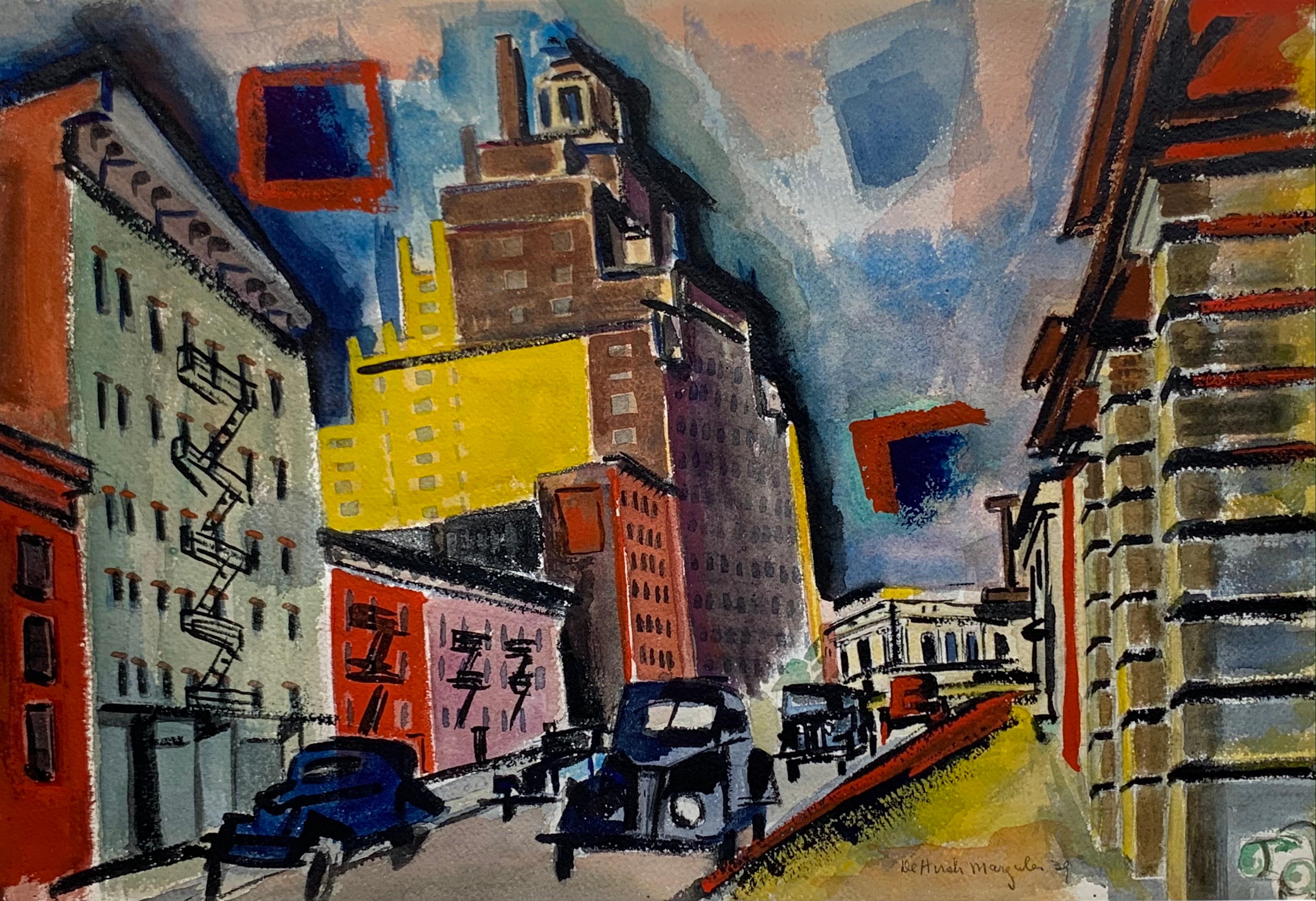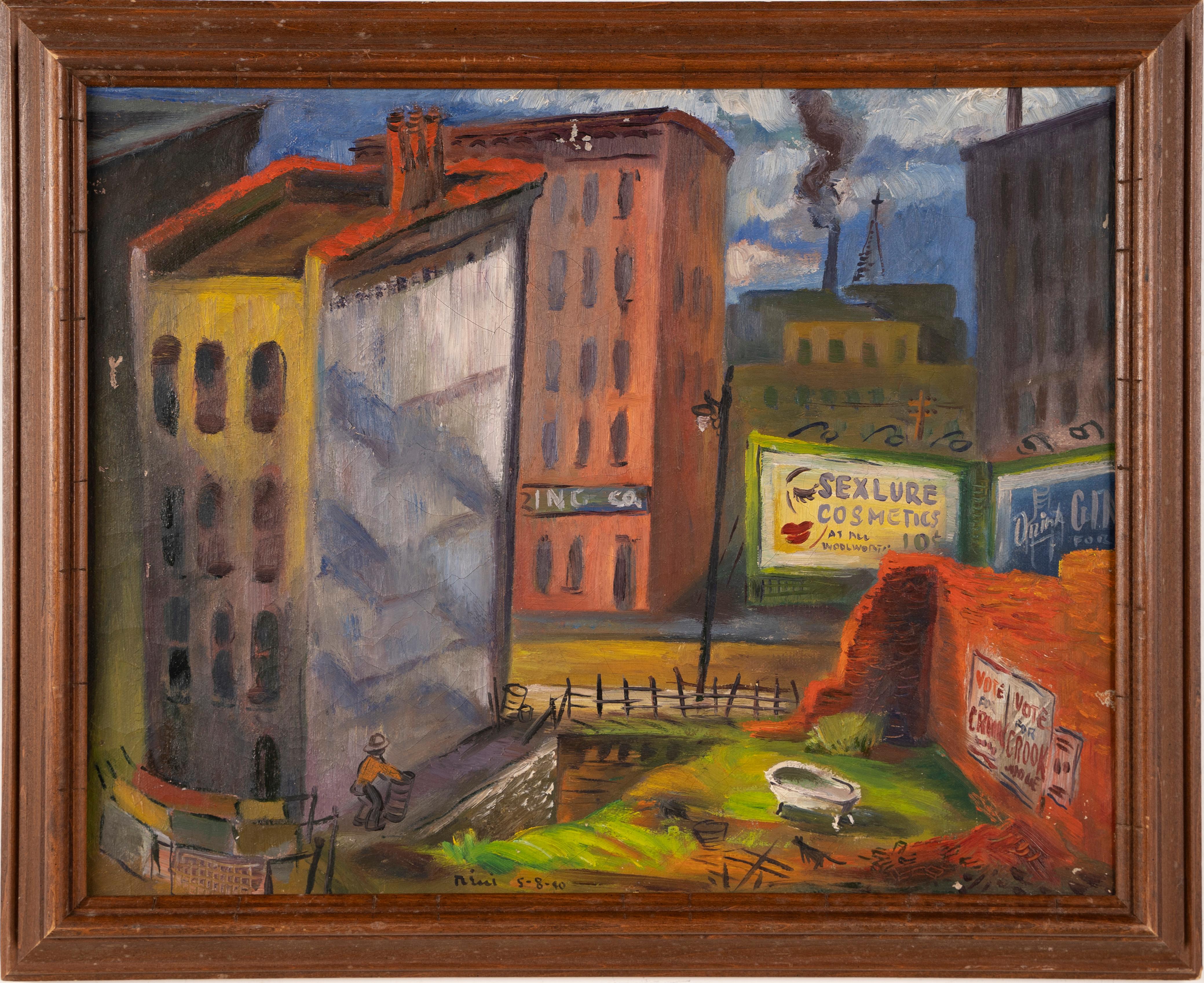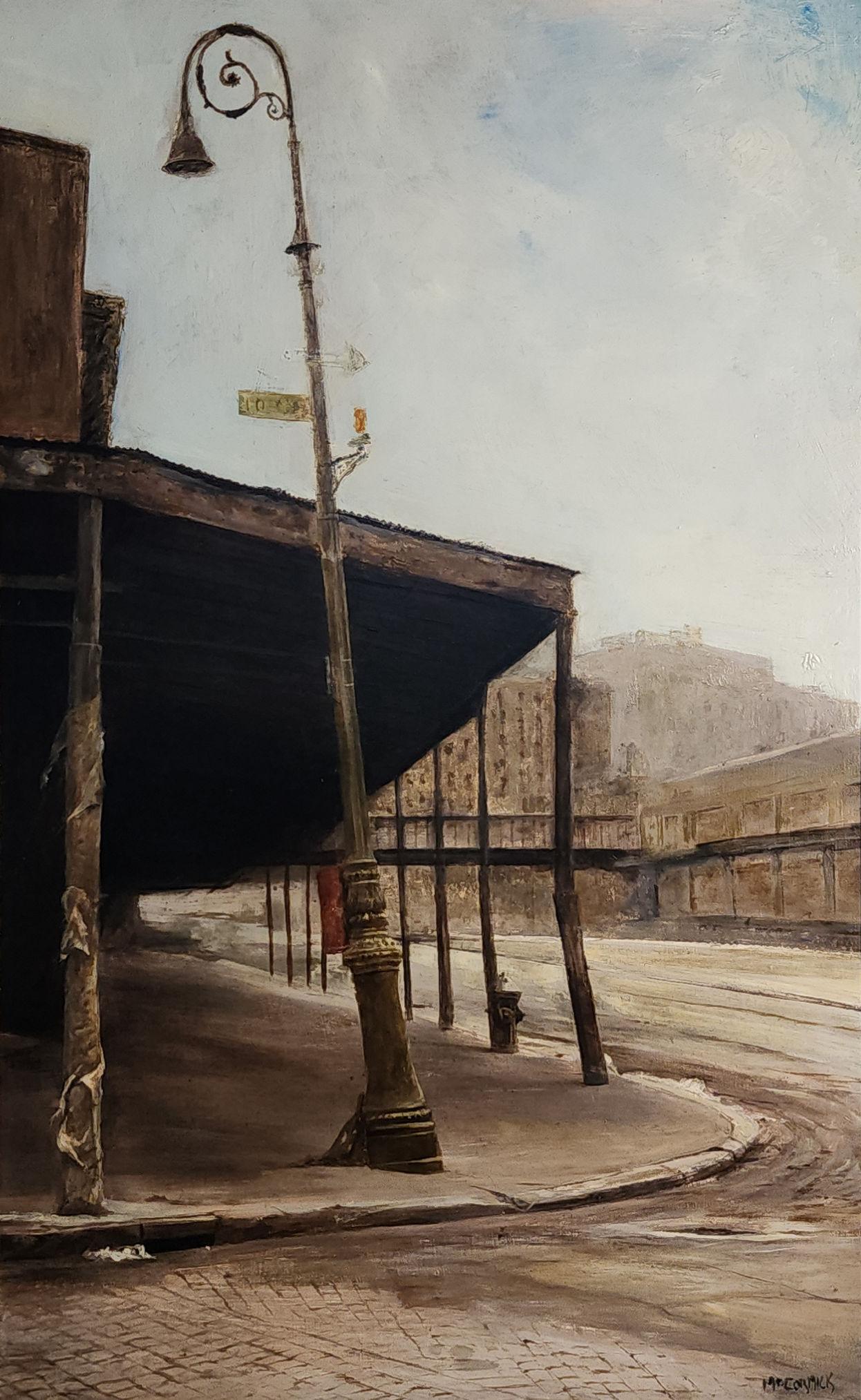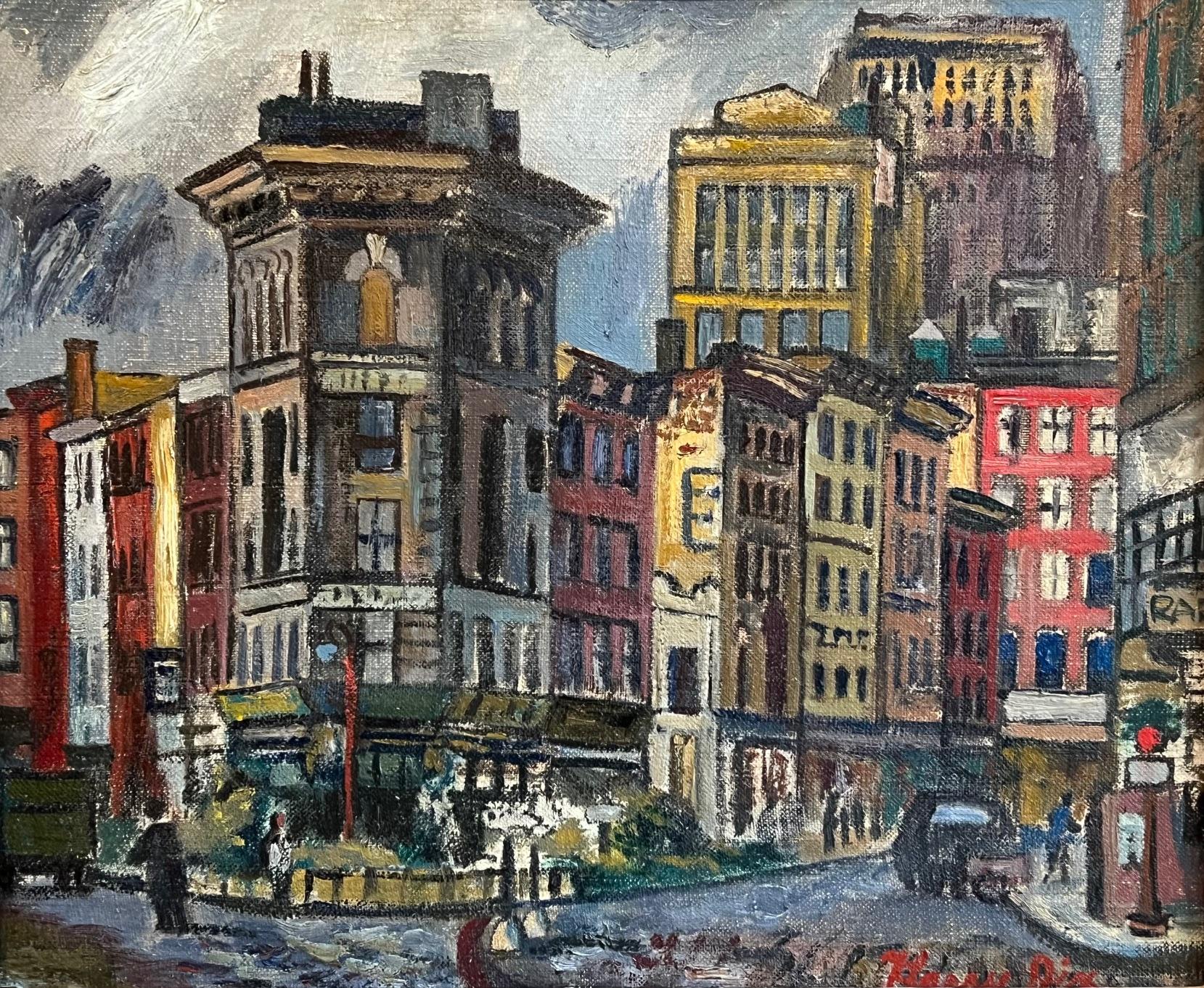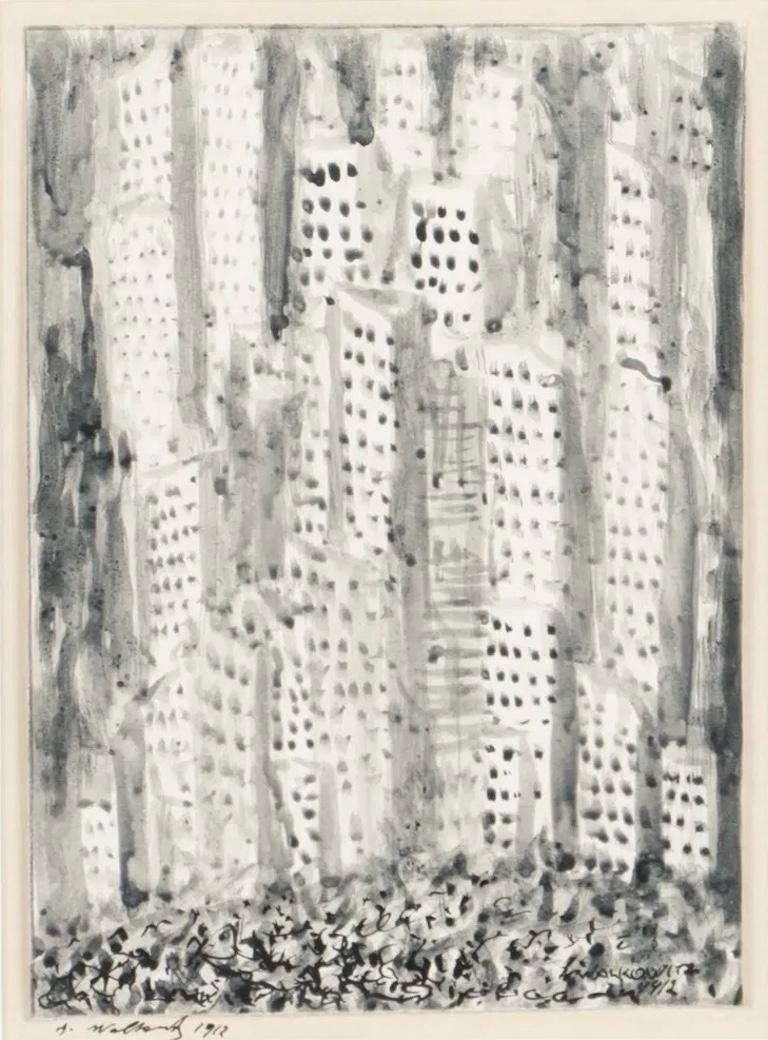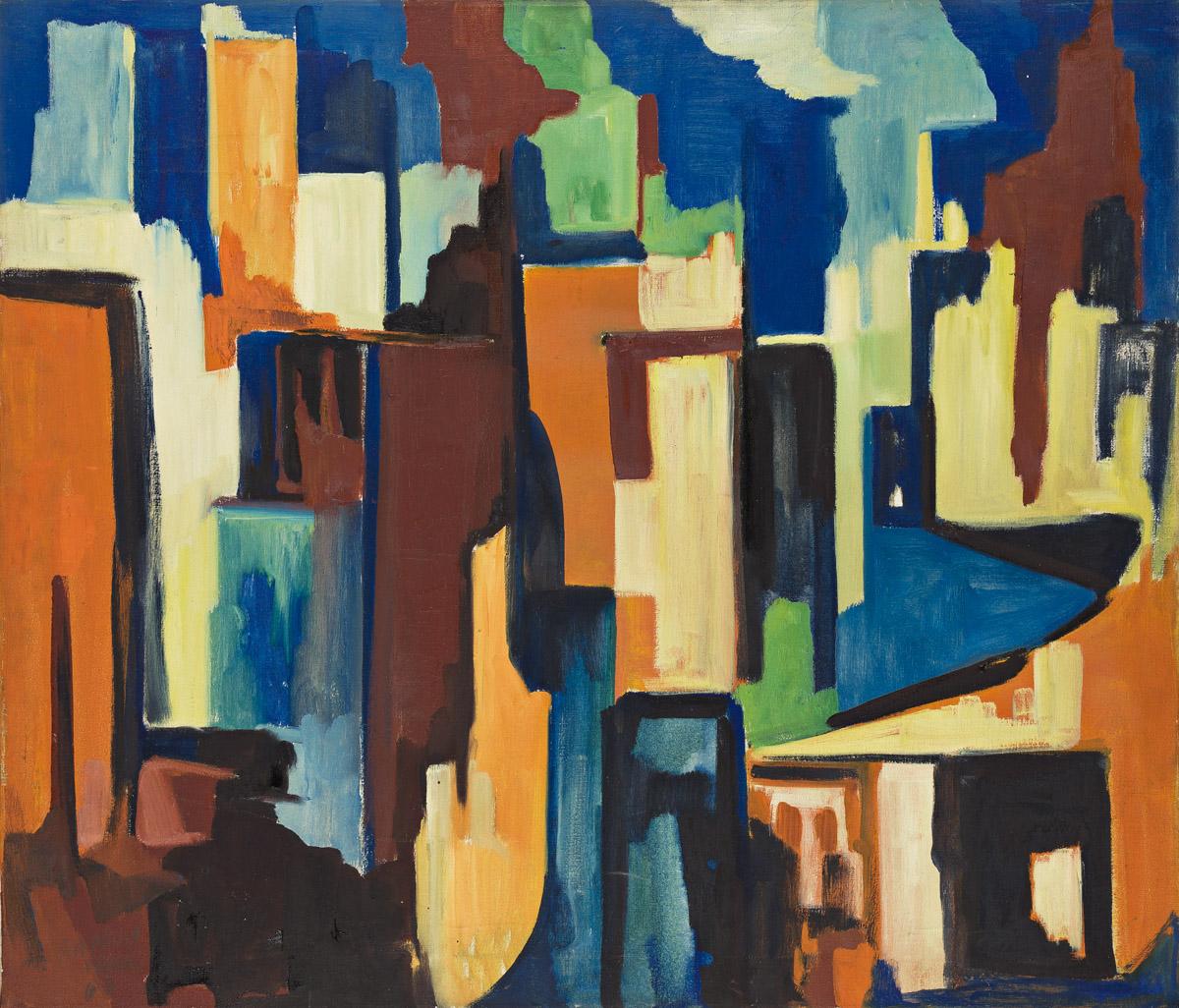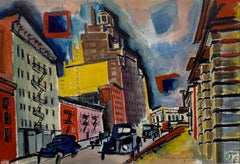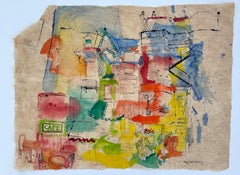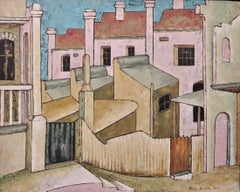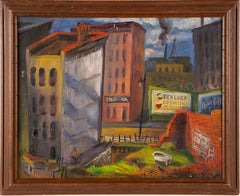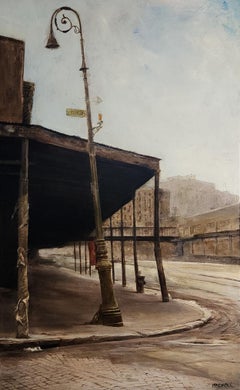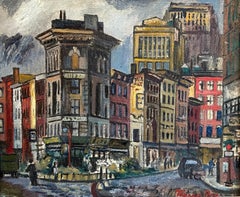Items Similar to North on West Street (West Side Highway NYC Cityscape)
Want more images or videos?
Request additional images or videos from the seller
1 of 17
De Hirsch MargulesNorth on West Street (West Side Highway NYC Cityscape)1939
1939
$6,000
$7,50020% Off
£4,562.04
£5,702.5520% Off
€5,255.53
€6,569.4120% Off
CA$8,530.42
CA$10,663.0320% Off
A$9,271.10
A$11,588.8820% Off
CHF 4,899.41
CHF 6,124.2720% Off
MX$112,160.33
MX$140,200.4120% Off
NOK 61,018.73
NOK 76,273.4120% Off
SEK 57,635.98
SEK 72,044.9820% Off
DKK 39,238.49
DKK 49,048.1120% Off
About the Item
De Hirsh Margules (1899-1965). North on West Street , 1939. Watercolor on Arches wove paper. Signed and dated in pencil by artist lower margin. Sheet measures 15 x 22 inches. Framed measurement: 27 x 34 inched. Incredibly vibrant and saturated color with no fading or toning of sheet.
Provenance: Babcock Galleries, NYC
De Hirsh Margules (1899–1965) was a Romanian-American "abstract realist" painter who crossed paths with many major American artistic and intellectual figures of the first half of the 20th century. Elaine de Kooning said that he was "[w]idely recognized as one of the most gifted and erudite watercolorists in the country". The New York Times critic Howard Devree stated in 1938 that "Margules uses color in a breath-taking manner. A keen observer, he eliminates scrupulously without distortion of his material." Devree later called Margules "one of our most daring experimentalists in the medium"
Margules was also a well-known participant in the bohemian culture of New York City's Greenwich Village, where he was widely known as the "Baron" of Greenwich Village.[1] The New York Times described him as "one of Greenwich Village's best-known personalities" and "one of the best known and most buoyant characters about Greenwich Village.
Early Life
De Hirsh Margules was born in 1899 in the Romanian city of Iași (also known as Iasse, Jassy, or Jasse). When Margules was 10 weeks old, his family immigrated to New York City. Both of his parents were active in the Yiddish theater, His father was Yekutiel "Edward" Margules, a "renowned Jewish actor-impresario and founder of the Yiddish stage." Margules' mother, Rosa, thirty-nine years younger than his father, was an actress in the Yiddish theater and later in vaudeville. Although Margules appeared as a child actor with the Adler Family[11] and Bertha Kalich, his sister, Annette Margules, somewhat dubiously continued in family theater and vaudeville tradition, creating the blackface role of the lightly-clad Tondelayo (a part later played on film Hedy Lamarr) in Earl Carroll's 1924 Broadway exoticist hit, White Cargo. Annette herself faced stereotyping as an exotic flower: writing about her publicist Charles Bouchert stated that "Romania produces a stormy, temperamental type of woman---a type admirably fitted to portray emotion." His brother Samuel became a noted magician who appeared under the name "Rami-Sami." Samuel later became a lawyer, representing magician Horace Goldin, among others. A family portrait including a young De Hirsh, a portrait of Rosa and Annette together, and individual photos of Rosa and Edward can be found on the Museum of the City of New York website.
At around age 9 or 10, Margules took art classes with the Boys Club on East Tenth Street, and his first taste of exhibition was at a student art show presented by the club. By age 11, he had won a city-wide prize (a box camera) at a children's art show presented by the department store Wanamakers.
As a young teenager, Margules was already displaying a characteristic kindness and loyalty. Upon hearing that two friends (one of them was author Alexander King), were in trouble for breaking a school microscope, the nearly broke Margules gave them five dollars to repair the microscope . Margules had to approach a wealthy man that Margules had once saved on the subway from a heart attack. Margules didn't reveal the source of the five dollars to King until twenty-five years later.
In his late teens, Margules studied for a couple of months in Pittsburgh with Edwin Randby, a follower of Western painter Frederic Remington. Thereafter he pursued a two-year course of studies in architecture, design and decoration at the New York Evening School of Art and Design, while working as a clerk during the day at Stern's Department Store. He was encouraged in these artistic pursuits by his neighbor, the painter Benno Greenstein (who later went by the name of Benjamin Benno).
Artistic career
In 1922, Margules began work as a police reporter for the City News Association of New York .Margules then considered himself something of an expert on art, and the painter Myron Lechay is said to have responded to some unsolicited analysis of his work with the remark "Since you seem to know so much about it, why don't you paint yourself?" This led to study with Lechay and a flurry of painting.
Margules' first show was in 1922 at Jane Heap's Little Review Gallery. Thereafter Margules began to participate in shows with a group including Stuart Davis, Jan Matulka, Buckminster Fuller (exhibiting depictions of his "Dymaxion house") in a gallery run by art-lover and restaurateur Romany Marie on the floor above her cafe.
Jane Heap, left, with Mina Loy and Ezra Pound
During the 1920s, Margules traveled outside of the country a number of times. In 1922, with the intent of reaching Bali, he took a job as a "'wiper on a tramp steamer where [he] played nursemaid to the engine." He reached Rotterdam before he turned back. He would return to Rotterdam shortly thereafter.
In 1927, Margules took a lengthy leave of absence from his day job as a police reporter in order to travel to Paris, where he "set up a studio in Montmartre's Place du Tertre, on the top floor of an almost deserted hotel, a shabby establishment, lacking both heat and running water." He studied at the Louvre and traveled to paint landscapes in provincial France and North Africa.
Margules also joined the "Noctambulist" movement and experimented with painting and showing his artwork in low light.Jonathan Cott wrote that:
the painter De Hirsch Margulies sat on the quays of the Seine and painted pictures in the dark. In fact, the first exhibition of these paintings, which could be seen only in a darkened room, took place in [ Walter Lowenfels'] Paris apartment.
Elaine de Kooning remarked that studying the works of the Noctambulists confirmed Margules' "direction toward the use of primary colors for perverse effects of heavy shadow."
It was also in Paris that Margules initially conceived his idea of "Time Painting", where a painting is divided into sectors, each representing a different time of day, with color choices meant to evoke that time of day.
In Paris, his social circle included Lowenfels, photographer Berenice Abbott, publisher Jane Heap, composer George Anthiel, sculptor Thelma Wood, painter André Favory, writer Norman Douglas, writer and editor George Davis, composer and writer Max Ewing, and writer Michael Fraenkel.
Upon his return to New York in 1929, Margules attended an exhibition of John Marin's paintings.
While at the exhibition, he "launched into an eloquent explanation of Marin to two nearby women", and was overheard by an impressed Alfred Stieglitz. The famous photographer and art promoter invited Margules to dine with his wife, the artist Georgia O'Keeffe, and his assistant, painter Emil Zoler. Stieglitz thereafter became a friend and mentor to Margules, becoming for him "what Socrates was to his friends."
Alfred Stieglitz
Stieglitz introduced Margules to John Marin, who quickly became the most important painterly influence upon Margules. Elaine de Kooning later noted that Margules was "indebted to Marin and through Marin to Cézanne for his initial conceptual approach - for his constructions of scenes with no negative elements, for skies that loom with the impact of mountains." Margules himself said that Marin was his "father and ... academy." The admiration was by no means unreciprocated: Marin said that Margules was "an art lover with abounding faith and sincerity, with much intelligence and quick seeing." Stieglitz also introduced Margules to many other artistic and intellectual figures in New York.
With the encouragement of Alfred Stieglitz, Margules in 1936 opened a two-room gallery at 43 West 8th Street called "Another Place." Over the following two years there were fourteen solo exhibitions by Margules and others, and the gallery was well-respected by the press. It was in this gallery that the painter James Lechay, Myron's brother, exhibited his first painting.
In 1936, Margules first saw recognition by major art museums when both the Museum of Modern Art and the Museum of Fine Arts, Boston purchased his works.
In 1942, Margules gave up working as a police reporter, and apparently dedicated himself thereafter solely to an artistic vocation.
"The Baron of Greenwich Village"[edit]
Margules made his mark not only as an artist, but also as an outsized personality known throughout Greenwich Village and beyond.
To local residents, Margules was known as the "Baron", after Baron Maurice de Hirsch, a prominent German Jewish philanthropist. Margules was easily recognizable by the beret he routinely wore over his long hair. Writer Charles Norman said that he "dressed with a flair for sloppiness."
He was said to "know everybody" in Greenwich Village, to the extent that when the novelist and poet Maxwell Bodenheim was murdered, Margules was the first one the police sought to identify the body. Margules' letters show him interacting with art world figures such as Sacha Kolin, John Marin and Alfred Stieglitz, as well as with prominent figures outside the art world such as polymath Buckminster Fuller and writer Henry Miller.
Most of his friends and acquaintances found Margules a generous and voluble man, given to broadly emotionally expressive gestures and acts of kindness and loyalty. In 1929, he exhibited an example of this loyalty and fellow-feeling when he appeared in court to fight what the wrongful commitment of his friend, writer and sculptor Alfred Dreyfuss, who appeared to have been a victim of an illicit attempt to block an inheritance.
The Greenwich Village chronicler Charles Norman described the bone-crushing hugs that Margules would routinely bestow on his friends and acquaintances, and speaks of the "persuasive theatricality" that Margules seemed to have inherited from his actor parents. Norman also wrote about Margules' routine acts of kindness, taking in homeless artists, constantly feeding his friends and providing the salvatory loan where needed. Norman also notes that Margules was blessed with a loud and good voice, and was apt to sing an operatic air without provocation.
The writer and television personality Alexander King said
I think the outstanding characteristics of my friend's personality are affirmation, emphasis, and overemphasis. He chooses to express himself predominantly in superlatives and the gestures which accompany his utterances are sometimes dangerous to life and limb. Of the bystanders, I mean.
King also spoke with affectionate amusement about Margules' pride in his cooking, speaking of how "if he should ever invite you to dinner, he may serve you a hamburger with onions, in his kitchen-living room, with such an air of gastronomic protocol, such mysterious hints and ogliing innuendoes, as if César Ritz and Brillat-Savarin had sneaked out, only a moment before, with his secret recipe in their pockets."
Margules was such a memorable New York personality that comic book writer Alvin Schwartz imagined him at the Sixth Avenue Cafeteria in a risible yet poignant debate with Clark Kent about whether Superman had the ability to stop Hitler.
Margules' entrenchment in the Greenwich Village milieu can be seen in a photograph from Fred McDarrah's "Beat Generation Album" of a January 13, 1961 writers' and poets' meeting to discuss "The Funeral of the Beat Generation", in Robert Cordier [fr]'s railroad flat at 85 Christopher Street. Among the people in the same photograph are Shel Silverstein, Lester Blackiston, James Baldwin, Norman Mailer, beat poet Howard Hart,[54] and Ted Joans. Incidentally, Hart mentioned Margules in his poem "Thelonius Monk," referring to the "thin wood rocking chair De Hirsch Margules's weight / Had busted Bless him now and forever."
More photos of Margules can be seen on the Smithsonian's "Archives of American Art" website, which has three photos which capture Margules' innate theatricality. One of them shows Margules (wearing his customary beret) jumping with child-like glee in a New York City Park, surrounded by a flurry of pigeons. Another[ shows Margules in his studio, brush in hand, posing in front of one of his paintings. A third also taken in a New York City park, shows Margules in a display of mock-pomp, his hand inside his shirt a la Napoleon Bonaparte.
Death
Among the three articles The New York Times dedicated to Margules' death was a mournful paean to lost Greenwich Village life written by Bernard Weinraub: "The Baron was De Hirsh Margules, painter, poet and newspaper reporter. He was remembered yesterday, on his burial, with the same gusto that marked his life in the Village."
Maurice, the self-styled "Prince of Bohemia" of Greenwich Village, remarked that
Once there were so many genuine Bohemians in the Village. But now, so few oldtimers are left. Jake Spencer and Earl Kirkham and Harrison Doud are gone--all gone. And now the Baron.
Artist Leslie Jencel was quoted as saying
I'm wearing my black leather cape today because De Hirsh would have wanted me to. He had such a sense of drama, of color. He had such a spirit of youth and creativity-a rare and wise and unusual man.
Another artist, Aristodimos Kaldis, said
He was one of the last of the true Villagers. We used to go to the old Waldorf Cafeteria on Sixth Avenue and debate esthetics-whether Rembrandt was the master of light, or El Greco or Tintoretto. We used to debate all night. Now of course, those days are gone.
Margules' sister, actress Annette Margules, remembered him as
charitable and generous to all who needed help. He took care of people, he even fed people. Why, last night, people came up to me and said, 'How am I going to eat now that De Hirsh is gone?
The supposedly penniless Margules left an estate of more than $100,000, the amount and circumstances of which were enough to merit a The New York Times article and a mention by nationally syndicated celebrity columnist Leonard Lyons, who remarked
the big shock to Greenwich Village's Bohemian colony last week was in learning that the Bohemian painter, de Hirsch Margolis [sic], left a huge estate. He was a stock market wizard.
(This is a conclusion that has been disputed with by Charles Norman, who stated that collector Harrison D. Horblit purchased all remaining Margules paintings "in order to swell the estate.")
Among the forty-five people sharing in his estate were "beneficiaries living in such diverse areas as Greenwich Village, Paris, Niagara Falls, Oyster Bay, and the Lower East Side of Manhattan."
One Christopher St. New York, NY 10014
1 Christopher St. New York, NY 10014
- Creator:
- Creation Year:1939
- Dimensions:Height: 15 in (38.1 cm)Width: 22 in (55.88 cm)
- Medium:
- Movement & Style:
- Period:
- Condition:
- Gallery Location:Wilton Manors, FL
- Reference Number:1stDibs: LU24527678302
About the Seller
4.9
Platinum Seller
Premium sellers with a 4.7+ rating and 24-hour response times
Established in 2007
1stDibs seller since 2015
425 sales on 1stDibs
Typical response time: 2 hours
- ShippingRetrieving quote...Shipping from: Wilton Manors, FL
- Return Policy
Authenticity Guarantee
In the unlikely event there’s an issue with an item’s authenticity, contact us within 1 year for a full refund. DetailsMoney-Back Guarantee
If your item is not as described, is damaged in transit, or does not arrive, contact us within 7 days for a full refund. Details24-Hour Cancellation
You have a 24-hour grace period in which to reconsider your purchase, with no questions asked.Vetted Professional Sellers
Our world-class sellers must adhere to strict standards for service and quality, maintaining the integrity of our listings.Price-Match Guarantee
If you find that a seller listed the same item for a lower price elsewhere, we’ll match it.Trusted Global Delivery
Our best-in-class carrier network provides specialized shipping options worldwide, including custom delivery.More From This Seller
View AllChristopher Street (abstract Greenwich Village cityscape)
By De Hirsch Margules
Located in Wilton Manors, FL
De Hirsh Margules (1899-1965). Christopher Street, 1939. Watercolor on Arches wove paper. Signed and dated in pencil by artist lower margin. Sheet measures 15.5 x 20 inches. Window in matting measures 15 x 19 inches. Framed measurement: 23 x 30 inched. Bears fragment of original label affixed on verso. Incredibly vibrant and saturated color with no fading or toning of sheet.
Provenance: Babcock Galleries, NYC
Exhibited: The American Federation of Arts Traveling Exhibition.
From the facade of The Waverly at Christopher is depicted One Christopher Street, the 16-story Art Deco residential building erected in 1931. It is not a casual coincidence that the structure appears in this cityscape: 1 Christopher Street is the subject. The original intention of this project was to transform the neighborhood, bring a bit of affluence and make a bid to rival the Upper West Side. Margules, a sensitive aesthete, understood how a massive piece of architecture such as One changes a neighborhood. Sound, scale and focal points are forever altered. A pedestrian's sense of depth and distance becomes pronounced. All of these factors contribute to the intent behind this image. Tall buildings disrupt the human scale, change the skyline and carve up space. In this piece, negative space conforms to the man-made geometries. Clouds become gems fixed in settings.
De Hirsh Margules (1899–1965) was a Romanian-American "abstract realist" painter who crossed paths with many major American artistic and intellectual figures of the first half of the 20th century. Elaine de Kooning said that he was "[w]idely recognized as one of the most gifted and erudite watercolorists in the country". The New York Times critic Howard Devree stated in 1938 that "Margules uses color in a breath-taking manner. A keen observer, he eliminates scrupulously without distortion of his material." Devree later called Margules "one of our most daring experimentalists in the medium"
Margules was also a well-known participant in the bohemian culture of New York City's Greenwich Village, where he was widely known as the "Baron" of Greenwich Village.[1] The New York Times described him as "one of Greenwich Village's best-known personalities" and "one of the best known and most buoyant characters about Greenwich Village.
Early Life
De Hirsh Margules was born in 1899 in the Romanian city of Iași (also known as Iasse, Jassy, or Jasse). When Margules was 10 weeks old, his family immigrated to New York City. Both of his parents were active in the Yiddish theater, His father was Yekutiel "Edward" Margules, a "renowned Jewish actor-impresario and founder of the Yiddish stage." Margules' mother, Rosa, thirty-nine years younger than his father, was an actress in the Yiddish theater and later in vaudeville. Although Margules appeared as a child actor with the Adler Family[11] and Bertha Kalich, his sister, Annette Margules, somewhat dubiously continued in family theater and vaudeville tradition, creating the blackface role of the lightly-clad Tondelayo (a part later played on film Hedy Lamarr) in Earl Carroll's 1924 Broadway exoticist hit, White Cargo. Annette herself faced stereotyping as an exotic flower: writing about her publicist Charles Bouchert stated that "Romania produces a stormy, temperamental type of woman---a type admirably fitted to portray emotion." His brother Samuel became a noted magician who appeared under the name "Rami-Sami." Samuel later became a lawyer, representing magician Horace Goldin, among others. A family portrait including a young De Hirsh, a portrait of Rosa and Annette together, and individual photos of Rosa and Edward can be found on the Museum of the City of New York website.
At around age 9 or 10, Margules took art classes with the Boys Club on East Tenth Street, and his first taste of exhibition was at a student art show presented by the club. By age 11, he had won a city-wide prize (a box camera) at a children's art show presented by the department store Wanamakers.
As a young teenager, Margules was already displaying a characteristic kindness and loyalty. Upon hearing that two friends (one of them was author Alexander King), were in trouble for breaking a school microscope, the nearly broke Margules gave them five dollars to repair the microscope . Margules had to approach a wealthy man that Margules had once saved on the subway from a heart attack. Margules didn't reveal the source of the five dollars to King until twenty-five years later.
In his late teens, Margules studied for a couple of months in Pittsburgh with Edwin Randby, a follower of Western painter Frederic Remington. Thereafter he pursued a two-year course of studies in architecture, design and decoration at the New York Evening School of Art and Design, while working as a clerk during the day at Stern's Department Store. He was encouraged in these artistic pursuits by his neighbor, the painter Benno Greenstein (who later went by the name of Benjamin Benno).
Artistic career
In 1922, Margules began work as a police reporter for the City News Association of New York .Margules then considered himself something of an expert on art, and the painter Myron Lechay is said to have responded to some unsolicited analysis of his work with the remark "Since you seem to know so much about it, why don't you paint yourself?" This led to study with Lechay and a flurry of painting.
Margules' first show was in 1922 at Jane Heap's Little Review Gallery. Thereafter Margules began to participate in shows with a group including Stuart Davis, Jan Matulka, Buckminster Fuller (exhibiting depictions of his "Dymaxion house") in a gallery run by art-lover and restaurateur Romany Marie on the floor above her cafe.
Jane Heap, left, with Mina Loy and Ezra Pound
During the 1920s, Margules traveled outside of the country a number of times. In 1922, with the intent of reaching Bali, he took a job as a "'wiper on a tramp steamer where [he] played nursemaid to the engine." He reached Rotterdam before he turned back. He would return to Rotterdam shortly thereafter.
In 1927, Margules took a lengthy leave of absence from his day job as a police reporter in order to travel to Paris, where he "set up a studio in Montmartre's Place du Tertre, on the top floor of an almost deserted hotel, a shabby establishment, lacking both heat and running water." He studied at the Louvre and traveled to paint landscapes in provincial France and North Africa.
Margules also joined the "Noctambulist" movement and experimented with painting and showing his artwork in low light.Jonathan Cott wrote that:
the painter De Hirsch Margulies sat on the quays of the Seine and painted pictures in the dark. In fact, the first exhibition of these paintings, which could be seen only in a darkened room, took place in [ Walter Lowenfels'] Paris apartment.
Elaine de Kooning remarked that studying the works of the Noctambulists confirmed Margules' "direction toward the use of primary colors for perverse effects of heavy shadow."
It was also in Paris that Margules initially conceived his idea of "Time Painting", where a painting is divided into sectors, each representing a different time of day, with color choices meant to evoke that time of day.
In Paris, his social circle included Lowenfels, photographer Berenice Abbott, publisher Jane Heap, composer George Anthiel, sculptor Thelma Wood, painter André Favory, writer Norman Douglas, writer and editor George Davis, composer and writer Max Ewing, and writer Michael Fraenkel.
Upon his return to New York in 1929, Margules attended an exhibition of John Marin's paintings.
While at the exhibition, he "launched into an eloquent explanation of Marin to two nearby women", and was overheard by an impressed Alfred Stieglitz. The famous photographer and art promoter invited Margules to dine with his wife, the artist Georgia O'Keeffe, and his assistant, painter Emil Zoler. Stieglitz thereafter became a friend and mentor to Margules, becoming for him "what Socrates was to his friends."
Alfred Stieglitz
Stieglitz introduced Margules to John Marin, who quickly became the most important painterly influence upon Margules. Elaine de Kooning later noted that Margules was "indebted to Marin and through Marin to Cézanne for his initial conceptual approach - for his constructions of scenes with no negative elements, for skies that loom with the impact of mountains." Margules himself said that Marin was his "father and ... academy." The admiration was by no means unreciprocated: Marin said that Margules was "an art lover with abounding faith and sincerity, with much intelligence and quick seeing." Stieglitz also introduced Margules to many other artistic and intellectual figures in New York.
With the encouragement of Alfred Stieglitz, Margules in 1936 opened a two-room gallery at 43 West 8th Street called "Another Place." Over the following two years there were fourteen solo exhibitions by Margules and others, and the gallery was well-respected by the press. It was in this gallery that the painter James Lechay, Myron's brother, exhibited his first painting.
In 1936, Margules first saw recognition by major art museums when both the Museum of Modern Art and the Museum of Fine Arts, Boston purchased his works.
In 1942, Margules gave up working as a police reporter, and apparently dedicated himself thereafter solely to an artistic vocation.
"The Baron of Greenwich Village"[edit]
Margules made his mark not only as an artist, but also as an outsized personality known throughout Greenwich Village and beyond.
To local residents, Margules was known as the "Baron", after Baron Maurice de Hirsch, a prominent German Jewish philanthropist. Margules was easily recognizable by the beret he routinely wore over his long hair. Writer Charles Norman said that he "dressed with a flair for sloppiness."
He was said to "know everybody" in Greenwich Village, to the extent that when the novelist and poet Maxwell Bodenheim was murdered, Margules was the first one the police sought to identify the body. Margules' letters show him interacting with art world figures such as Sacha Kolin, John Marin and Alfred Stieglitz, as well as with prominent figures outside the art world such as polymath Buckminster Fuller and writer Henry Miller.
Most of his friends and acquaintances found Margules a generous and voluble man, given to broadly emotionally expressive gestures and acts of kindness and loyalty. In 1929, he exhibited an example of this loyalty and fellow-feeling when he appeared in court to fight what the wrongful commitment of his friend, writer and sculptor Alfred Dreyfuss, who appeared to have been a victim of an illicit attempt to block an inheritance.
The Greenwich Village chronicler Charles Norman described the bone-crushing hugs that Margules would routinely bestow on his friends and acquaintances, and speaks of the "persuasive theatricality" that Margules seemed to have inherited from his actor parents. Norman also wrote about Margules' routine acts of kindness, taking in homeless artists, constantly feeding his friends and providing the salvatory loan where needed. Norman also notes that Margules was blessed with a loud and good voice, and was apt to sing an operatic air without provocation.
The writer and television personality Alexander King said
I think the outstanding characteristics of my friend's personality are affirmation, emphasis, and overemphasis. He chooses to express himself predominantly in superlatives and the gestures which accompany his utterances are sometimes dangerous to life and limb. Of the bystanders, I mean.
King also spoke with affectionate amusement about Margules' pride in his cooking, speaking of how "if he should ever invite you to dinner, he may serve you a hamburger with onions, in his kitchen-living room, with such an air of gastronomic protocol, such mysterious hints and ogliing innuendoes, as if César Ritz and Brillat-Savarin had sneaked out, only a moment before, with his secret recipe in their pockets."
Margules was such a memorable New York personality that comic book writer Alvin Schwartz imagined him at the Sixth Avenue Cafeteria in a risible yet poignant debate with Clark Kent about whether Superman had the ability to stop Hitler.
Margules' entrenchment in the Greenwich Village milieu can be seen in a photograph from Fred McDarrah's "Beat Generation Album" of a January 13, 1961 writers' and poets' meeting to discuss "The Funeral of the Beat Generation", in Robert Cordier [fr]'s railroad flat at 85 Christopher Street. Among the people in the same photograph are Shel Silverstein...
Category
1930s American Modern Abstract Paintings
Materials
Watercolor, Rag Paper
$6,000 Sale Price
20% Off
Cubist East River industial scene
Located in Wilton Manors, FL
Joseph Kardonne (1911-1985). East River, 1966. 9.5 x 12.25 inches. Watercolor on paper, sheet measures inches. Signed, dated and titled lower right. Excellent condition.
Born in N...
Category
Mid-20th Century Cubist Abstract Paintings
Materials
Watercolor
Winston Flowers Newbury St. Boston Cityscape
Located in Wilton Manors, FL
Judi Rotenberg (20th century). Winston Flowers, Newbury St. Boston, ca. 1970. Ink and watercolor on Awagami paper, sheet measures 18.5 x 24 inches. Uppe...
Category
1970s Abstract Abstract Paintings
Materials
Watercolor, Handmade Paper
City Streets (British Street scene architectural landscape)
Located in Wilton Manors, FL
Rene Beckley. City Streets, 1965. Oil on artist board, 16 x 20 inches; 18 x 22 inches framed. Signed and dated lower right.
Category
Mid-20th Century Modern Landscape Paintings
Materials
Oil
$680 Sale Price
20% Off
Brattleboro Vermont VT Industrial Landscape
Located in Wilton Manors, FL
Joseph Kardonne (1911-1985). Brattleboro, VT., 1969. Watercolor on paper, sheet measures 18 x 22 inches. Measures 22.5 x 26.5 inches in custom float fr...
Category
Mid-20th Century Cubist Landscape Paintings
Materials
Watercolor
$900 Sale Price
55% Off
Ocean Beach Fire Island Cubist Painting
Located in Wilton Manors, FL
Joseph Kardonne (1911-1985). Ocean Beach, Fire Island, NY, 1946. Ink on paper, measuring 9 x 12 inches. Signed, dated and titled lower right. Unframed
...
Category
Mid-20th Century American Realist Landscape Paintings
Materials
Paper, Ink
$520 Sale Price
20% Off
You May Also Like
Antique American Modernist New York City Street Scene Abstract Oil Painting
Located in Buffalo, NY
Antique American modernist signed original oil painting. Oil on canvas, circa 1930. Signed illegibly. Image size 20L x 16H. Housed in a period giltwood frame.
Category
1920s Modern Landscape Paintings
Materials
Canvas, Oil
$796 Sale Price
20% Off
"10th Avenue, Meatpacking District" Harry McCormick, New York City Urban Scene
By Harry McCormick
Located in New York, NY
Harry McCormick
10th Avenue, Meatpacking District, New York
Signed lower right
Oil on masonite
23 7/8 x 15 inches
Renowned for his exquisite depiction of light and shadow, Harry Mc...
Category
1970s Contemporary Landscape Paintings
Materials
Masonite, Oil
Downtown New York
Located in Los Angeles, CA
Downtown New York, c. 1930s, oil on canvas, signed lower right, 10 x 12 inches; label verso reads: "Harry Dix / Title Downtown New York / Medium Oil"
Harry Dix was a 20th-century p...
Category
1930s American Modern Landscape Paintings
Materials
Canvas, Oil
"Abstract Cityscape" NYC Early 20th Century American Scene Social Realism Ashcan
By Abraham Walkowitz
Located in New York, NY
"Abstract Cityscape" NYC Early 20th Century American Scene Social Realism Ashcan
Abraham Walkowitz (American, 1878-1965)
Abstract Cityscape
Sight: 6 1/4' x 8 1/2 inches
Mixed media...
Category
1910s Abstract Landscape Drawings and Watercolors
Materials
Paper, Mixed Media
Skyline (New York)
Located in New York, NY
Oil on canvas. Signed, titled on stretcher on recto.
Bartolomucci was an Italian painter who became one of the founders of Astralism. He moved to New York in 1960 where he remain...
Category
1960s Abstract Expressionist Landscape Paintings
Materials
Canvas, Oil
A Dynamic Mid-Century Modern Manhattan Scene, New York City by Francis Chapin
By Francis Chapin
Located in Chicago, IL
A Large, Dynamic 1950s Mid-Century Modern Watercolor of Lower Manhattan, New York City by Noted Chicago Artist, Francis Chapin (Am. 1899-1965). The image is watercolor, pastel and c...
Category
Mid-20th Century American Modern Landscape Paintings
Materials
Watercolor, Archival Paper, Charcoal, Pastel
More Ways To Browse
Paris Apartment
Vintage Beret
Turn Of The Century Rocking Chairs
Beat Generation
Buckminster Fuller
St Christopher
Romanian Painter
How To Leave A Review
Alexander King
Niagara Falls Vintage
James Baldwin
Ezra Pound
Nyc Cityscape Paintings
Earl Spencer
Vintage Childs Rocking Chair 20th Century
Walter Paris
Hedy Lamarr
The Last Days Of Napoleon
